I was out rowing not long ago on a beautiful Vermont morning. There was no one but myself, a pair of loons, and a blue heron on the 900-acre pond, and the water so clear I could see small bass swimming in the weeds at the bottom. Above an unbroken shoreline of pines there was only blue sky and puffy white clouds. These are wonderful and fun times, and my Solo Packboat is what makes these moments possible.
Each 12′ Ultra-Light Solo Packboat is hand-crafted one at a time by the Martin brothers, Justin and Ian, of the Adirondack Guideboat Company (AGB) in North Ferrisburg, Vermont. It’s their latest innovation, inspired by the original cedar guideboats that have plied the lakes, rivers, and streams of New York State’s Adirondack Mountains since the middle of the 19th century, carrying sportsmen and their gear to places without roads. The boats needed to be tough for river bottoms, agile for streams, capable in whitecaps on windy lakes, large enough to carry plenty of cargo, and yet light enough to be portaged solo when needed. Although the Martins still build some boats from cedar, the majority are laid up with strong and light Kevlar hulls, with cherry gunwales and decks, and woven seats and backrests.
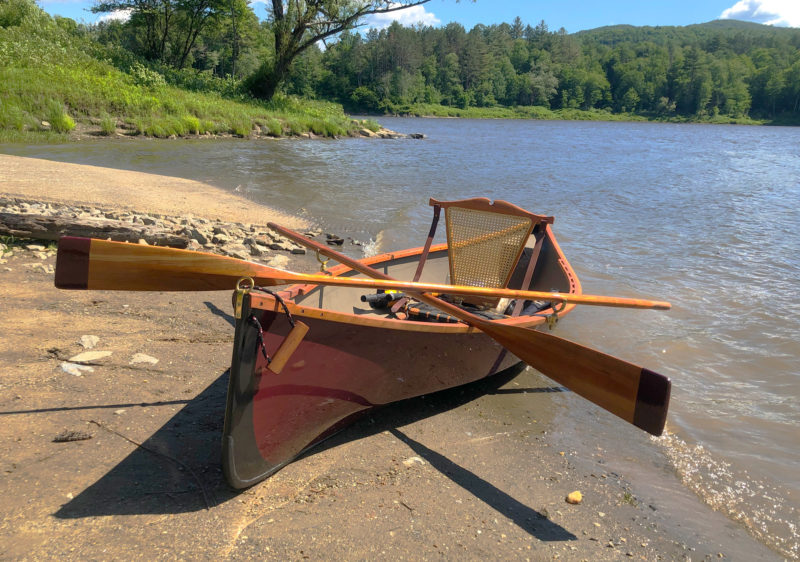 Photographs courtesy of the author
Photographs courtesy of the authorThe flat bottom is wide enough to keep the Packboat upright on a beach.
The Packboats are beautiful to look at whether red, black, forest green, yellow, white, or, what I chose, deep burgundy. All come with especially made, fine-grained cherry or maple oars. The oars offer more speed than paddles and provide power and stability to handle whatever arises on the water. All the fittings on the boat are heavy brass: oarlocks and pins and the tow rings on the decks. Leather straps support the backrests and give unlimited adjustability for comfort whether on a long row or a short fishing outing. You sit deep in these boats, close to the water and stable. The bottoms are coated with a heavy abrasion-resistant coating to withstand pulling over gravel or inadvertently hitting rocks or oyster beds.
AGB modified the original guideboats not only by modernizing the construction materials, but also by making design changes to enhance performance and functionality. Over the years I’ve owned all three models of AGB’s boats: a 15′, 60-lb Adirondack Guideboat; a 14′, 80-lb Vermont Dory; and now, the 12′, 34-lb Solo Packboat. I bought the Packboat for one main reason: easier handling from storage to car to dock. As my father said to me when he was 90 years old: “If you want to keep going, Boy, you gotta keep adapting”! Now that I’m approaching 80, I know that was sound advice.
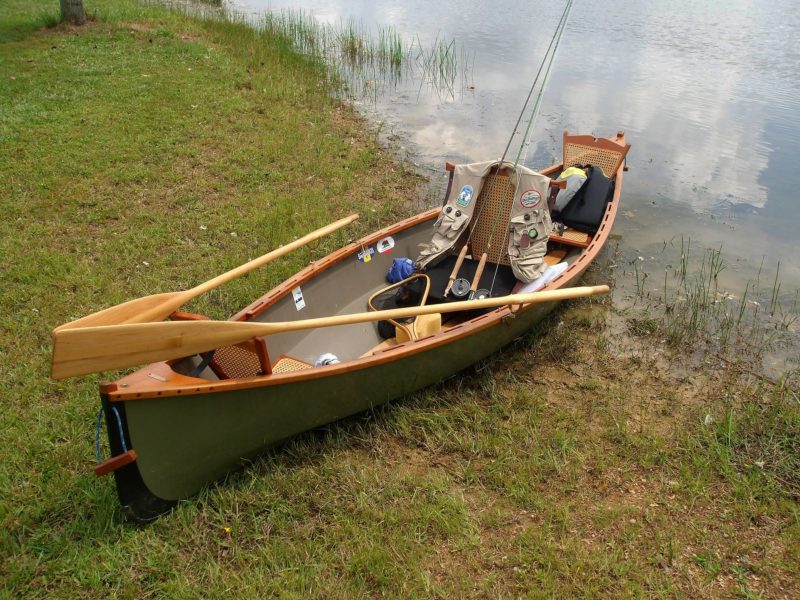 Adirondack Guideboat
Adirondack GuideboatEquipped with two optional seats, best suited for bringing a couple of kids along, this Packboat is decked out for fishing.
Of the three boats, I have to say that my Solo Packboat is turning out to be the most fun overall: it is shorter, lighter, narrower, and easier handling solo, on and off the water. While the other boats required a trailer-hitch T-bar extension to be carried in my pickup truck or SUV, the Packboat slides nicely in the back of either vehicle with only about 4′ protruding. I only have to lift one end of the boat onto the back of the car, and then lift the other end and slip it in. With two ropes to hold the boat down, I’m off. I can launch most anywhere from big-boat launch ramps to high-banked creeks and backwaters. A reasonably strong person can cartop this 34-lb boat but two people, of course, make the job easier.
The Packboat is wonderful on all kinds of water—calm ponds, blustery white-capped lakes, lively streams, and shallow backwaters—and takes the worry out of rowing it almost anywhere.
Entering the boat when it’s even just lightly grounded is easy. If the launch site is high-banked and the boat is fully afloat, it is a bit tricky getting in, but manageable. This gets easier with practice. I get out of the boat by using a “pull-up” rope I attached to the brass ring on the bow deck. I just pull myself up and step out. No trick to it, and it’s easy on the legs.
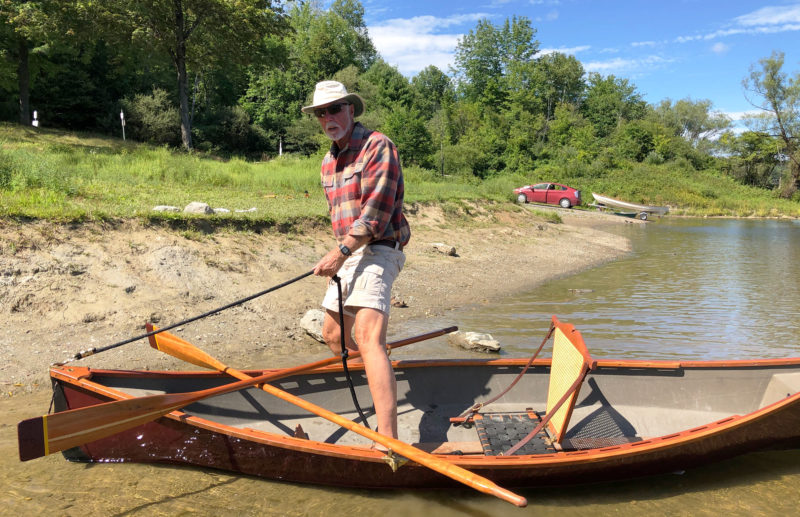
The author uses a rope to ease himself in and out of the boat.
Pulling away from shore is exhilarating—the boat is quick, runs true, and it almost seems to jump to the oar strokes. The Packboat gets up to speed pronto and holds its pace easily. Planting both oar blades deep and abruptly stops it quickly. The light weight, short length, and flat bottom give the Packboat exceptional agility. Pulling one oar and backing the other spins the boat around in place. To zigzag through tight turns, the boat responds immediately to light touches of one oar in the water, then the other. Just dipping a tip veers the bow right or left. It’s great fun. (My granddaughter is pretty good with the oars, too.)
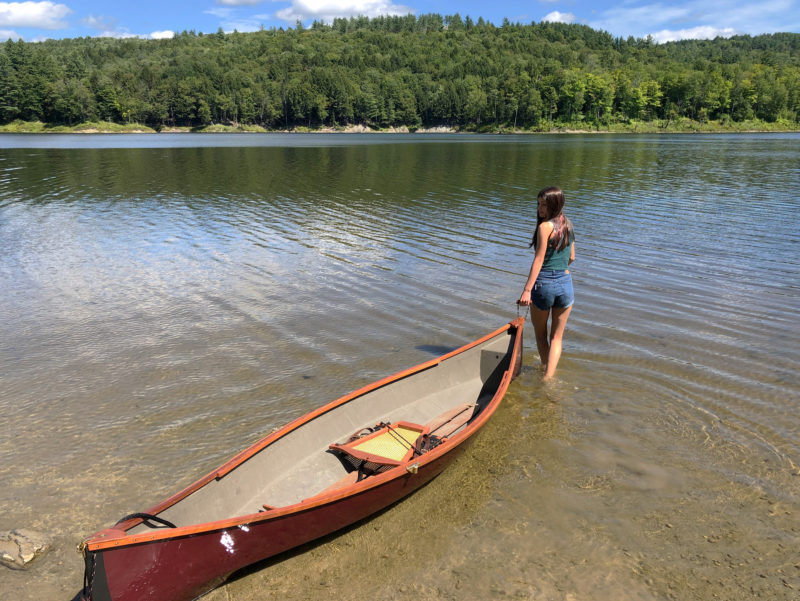
The boat’s 34-lb weight makes it easy to handle and its draft of about 4″ lets it skim over the shallows.
On one outing, caught by a wind that picked up suddenly and soon had the waves white-capping in a shallow lake, the Packboat handled the conditions well, cutting nicely into the waves or riding over them. It was clearly livelier than my other AGB boats, but, as my confidence in the boat grew, this was truly enjoyable. The Packboat was really at ease in rough water, especially when rowed straight into it. When I wheeled the boat and headed downwind, it tracked nicely, and I did some thrilling surfing when a breaker rose astern. I turned the boat beam-to the waves and at first got a jolt of adrenaline as the Packboat rolled side-to-side; then, confident that it wouldn’t capsize (in 20 years I’ve never had an AGB boat capsize or even take on water, and it has flotation tanks on both ends), I let myself go with the rodeo and rowed on for quite a way, and soon got used to the jostling. When taking the waves on the quarter, the little boat really excelled, and the touch of an oar allowed me to position the boat to catch wave after wave and rush forward, with the water coming up inches from the gunwale and racing by alongside. The Packboat performed like a sports car!
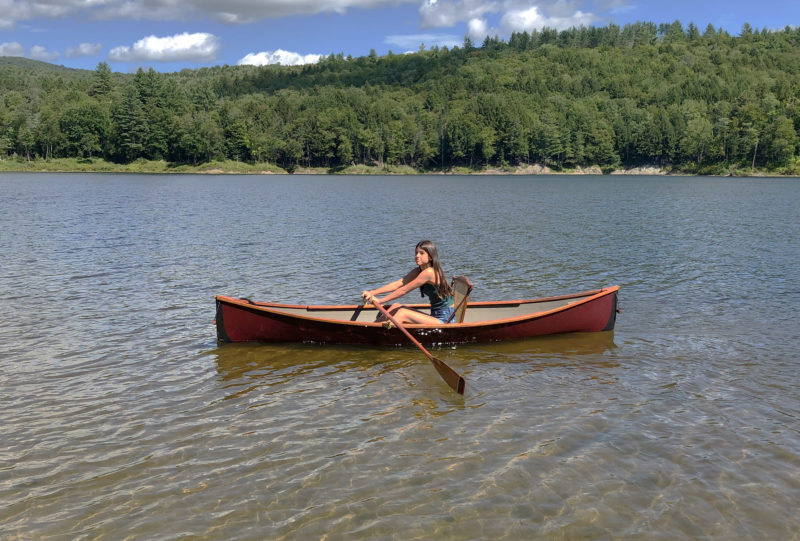
The Packboat is easily driven under oars. For aggressive rowing, the seat back folds forward and down to provide space for a layback at the finish of the stroke.
On another outing, in a stronger wind that was blowing flags straight out, the boat rose to meet the greater challenge. It was a pretty nasty day and mine was the only boat on the water. As rough as it was, the Packboat didn’t take in spray from the front or the sides, so I didn’t get wet. There was no need to push things, so I headed back in pretty soon, but assured that the boat could handle it. My learning curve in rough (and really rough) stuff was steep, and I was soon completely confident in the Packboat. The handling was superb, even playful.
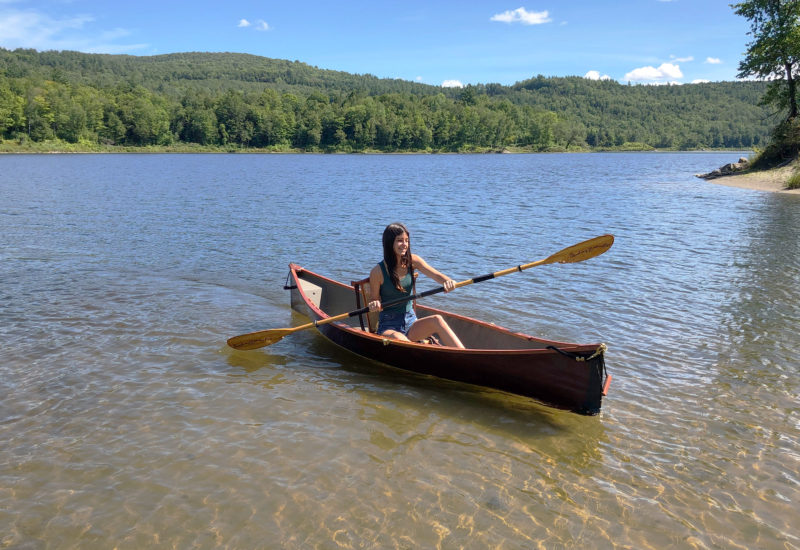
The 37-1/2″ beam of the Packboat makes it possible to use a kayak paddle when you want to travel stern first and see where you’re going.
While the Packboat is designed to be rowed, I’ve been surprised by how well it performs with a kayak paddle. From time to time, such as when I’m birdwatching in the swamps and rushes, I’d rather face the direction I’m going. Pushing both oars forward will do this, but the Packboat, with its narrow 37-1/2″ beam, takes well to being paddled like a kayak. Propelled by a double-bladed paddle, its quickness and agility again come through. I like to switch periodically from rowing to paddling—a change of pace, a rest for some muscles, and a good use of muscles otherwise not used. And, a kayak paddle makes it possible to thread through very tight spots on creeks and narrows. Of course, the Packboat takes well to a canoe paddle equally well. The adaptability to different forms of propulsion makes the boat nicely versatile.
The original Adirondack boats were built to haul multiple passengers and a week’s gear, and while the Solo Packboat is not capable of that, it’s not really tight on space either. When I was considering the switch to this boat, I was concerned that my 6′ 2″, 190-lb frame might not fit well, or might look awkward. That wasn’t so; the fit is definitely tighter, but not snug or the least bit restrictive. And its size hasn’t prevented me from heading out with the dog or a young grandkid, or lunch, or fishing gear, or even a guitar on calm rows. The Packboat is rated to carry 300 lbs, so it can carry me and another 100 lbs more.
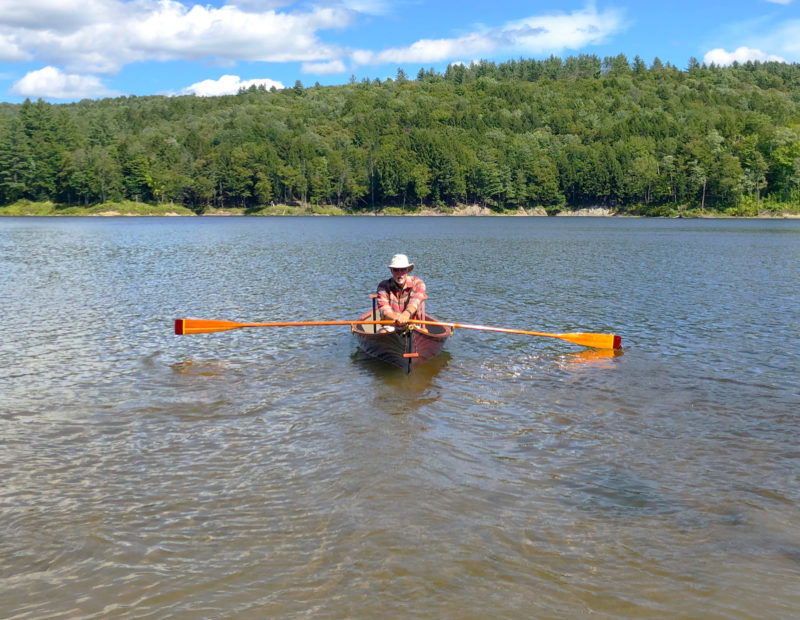
The oars have the pinned locks traditionally used in Adirondack guideboats. They prevent feathering the blades on the recovery of a stroke, but hold them in a vertical orientation that’s good for letting the oars trail when the boat coasts.
My age-driven switch to a smaller and lighter boat was a good decision; getting the Solo Packboat was a great decision. I’ve found that the “grab-and-go” ability of the boat really does make a difference in how much I get out on the water. A quick row before lunch or after dinner is not only possible but also fulfilling. I definitely did give up space for others—full-grown passengers, that is—but then “others” didn’t very often want to come with me on my long two-hour rows in the backwaters or when the wind was up and the waves curling. Rowing in these close-to-the water boats on no one’s timeline but one’s own is a personal experience best appreciated alone. For me, it’s what rowing is all about: a calm mind, rhythmically active muscles, outdoors and on the water. The Solo Packboat is made for just that and more. And, if your partner ever begins to feel left on the shore too often, just get another Packboat. The Martin brothers might just deliver it to your door.![]()
Mike Schmidt lives a cloistered life in the small town of New Smyrna Beach, Florida, near the mouth of the Indian River where it opens into the Atlantic. He rows lagoons, mangrove backwaters, and streams with birds and dolphins for company. Each spring, he and his wife move to the hills of Vermont to live in an old log cabin, surrounded by forest and overlooking a small trout pond. While in Vermont, he rows Lake Champlain, and its surrounding rivers and reservoirs and when not rowing, does sport shooting with a recurve bow and a shotgun, rides his bike, plays the guitar, works at playing golf, and, spends time with his grandkids.
Ultralight Solo Packboat Particulars
[table]
Length/12′
Weight/34 lbs
Beam/37.5″
Draft/~4″
[/table]
The 12′ Ultra-Light Solo Packboat is available from Adirondack Guideboat for $3,075, including cherry oars. Woven backrest $265. (Prices updated March 2022)
Is there a boat you’d like to know more about? Have you built one that you think other Small Boats Magazine readers would enjoy? Please email us!

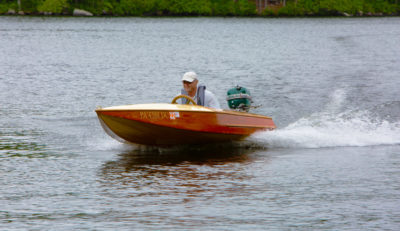
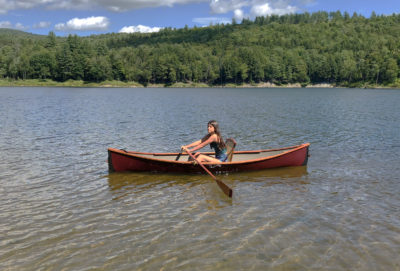
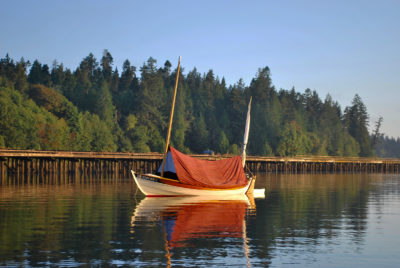
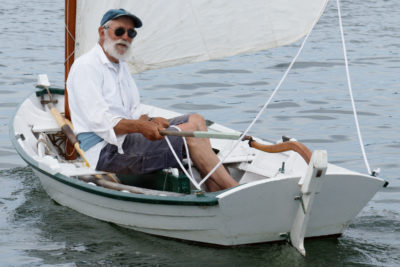
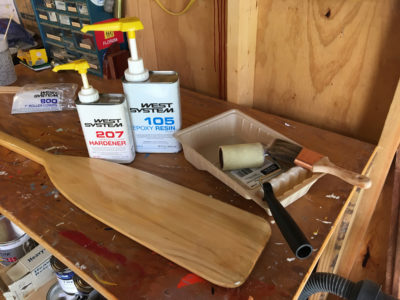
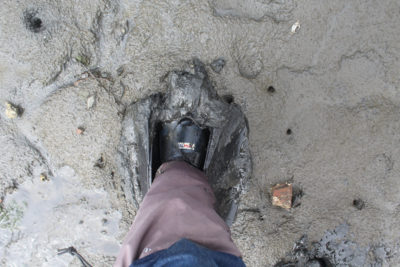
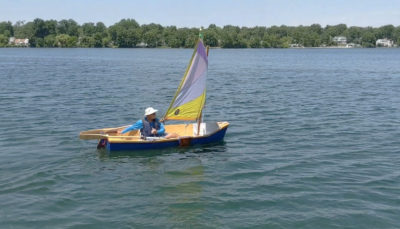
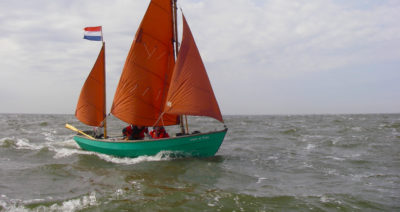

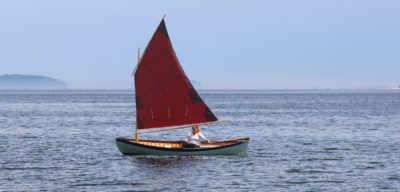
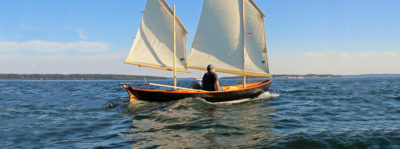
Mike, I enjoyed your comments on the Vermont Pack Boat. I have been rowing mine on Texas waters since 2009 when the Martins made a wide-ranging delivery run across country and stopped in Houston. They had two boats, a Dory and a Packboat. At age 73, I chose the Pack Boat because of light weight, easy on-off handling, and realizing that flat water was where I would mostly row.
I have been delighted with the sliding seat for exercise and woven cane seats and backs when I want to show it off. By far, the most boat for the money in every way.
I’ve rowed my gunning dory off the beach in Lake Michigan, alongside a friend who has a Vermont Pack Boat. He couldn’t help repeating an idea from Phil Bolger, that the city should reimburse us for adding to the scenic beauty of the lakefront. It’s a pretty gorgeous boat, and seemed to move effortlessly. It’s on my list of: I don’t really need another boat, but I’d sure like to own one of those!
I row a similar boat, a wooden kit canoe made by a competitor, same length and similar weight. The pull-up rope is brilliant. Going to try it. I’ve always kayak-paddled mine, switching to a short canoe paddle now and then, but haven’t thought to row it; am going to try that, seeing that it seems to work well in your AGB 12. I like how such boats quickly glide along at 3 mph without much effort, and with a little extra umph thrown in, are up near 4.
I’m going to try that pull-up rope to get my old body in and out of my canoe and kayak. Great idea…
Wonderful article by a writer in love with his boat…..a pleasure to read for me, landlocked in St Louis, MO. This would be a great boat for me, an 81-year-old published nature writer, if I had the water necessary for this great-looking, great-performing boat.
If I find a lake, I will order this boat. This enthusiastic article answered all my wonderings, returned my “boat lust” to me, making me wish again,I was back on Cape Cod. Thank you for this engaging article.
Beautiful boat. Seems funny to see people rowing it, as it looks very much like a canoe to me.
Mike, I don’t know what the odds are that you’ll see my comment, but I hope you do, as I want to thank you for your profile of the Solo Packboat. For over 30 years I’ve filled my cup of joy on the water in a Crawford Melonseed Skiff which has done everything I’ve asked, and more. But lately, I’ve had an urge to increase my options on the water, particularly with an eye on streamlining the process. Your article was instrumental in my choice. I’ve drooled over AGB’s bewitching Guideboats for years. But reading of the procession of boats in your life, starting with the Guideboat, and culminating in the Solo Packboat, reinforced my notions about the necessity for something light and easy for my frequent use, and solidified my choice to have the Martin brothers build a Solo Packboat of my own. This happily coincided with a show they were attending earlier this month and they dropped off my boat on their way. She’s a lovely little slip of a thing. I’m enchanted that she weighs the same as 4 gallons of milk! Less than a week after delivery, I stole a sunny, 45°F afternoon, cartopped her to my lake, and carried her on my shoulder to the water. Wow! What a delight. She’ll answer my needs perfectly. Every pretty boat deserves a name, and after that first time on the water, I chose LIGHTFOOT, the definition of which seems particularly fitting: “treading with light and nimble ease.” Thanks for putting me on the right path with your article, and best wishes for many more delightful days on the water.
I own the 12′ Solo Guideboat in Glacier Blue Metallic. It is a favorite of mine! It is NOT an easy boat to get out of with expensive cameras. AGB have been GREAT to deal with. The Martin Brothers are one of the best business people I have dealt with. We will be doing some high level video work with them this coming summer!